Rock River Valley Chapter of the Studebaker Drivers Club
Our Charter, Keeping the Studebaker Marque Alive
|
 |
|
|
 |
|
|
|
|
1953
Studebaker's would be the most talked about, most written about, and
also the last all new car design in Studebaker's history, albeit the
1963/64 Avanti. A Lowey design, with the actual lines laid down by
Robert Bourke. This design, at least the center sections, would be
used until the end of Studebaker production. It will be present in
all the Hawks; the 1956 to 1958 Sedans and Wagons (albeit with new
front and rear fenders, hoods, grilles, and deck lids); and the
entire Lark series with a stubbed up front and rear-end.
1953
is the point at which Studebaker first created two very different
body style designs. The first group, the two and four door sedan
models and the Land Cruiser. The second group would be the Starlight
coupe and the Starliner Hardtop. This design distinction would carry
through in the sedan line until 1958 and the Hawk series until 1961. To further explain, think about the two door sedan vs: the two door
Starlight coupe, both two door automobiles, but having nearly nothing
in common in the body structure. The doors, hood, trunk, and fenders
are all different. Only some trim and interior parts are
interchangeable. How did this happen?
First
while the Sedan design was in progress, Bourke, during his spare
time, was working on a Coupe design (C&K cars.) It was intended
as a styling study, with hopes it might be built as a show car. However, when Lowey presented Harold Vance and the Studebaker board
with the Coupe design, they decided to put the Coupe series into
production.
Some
think the sedan design should have been reworked to follow the coupe
design, but there just was not enough time to do that before fall
production would need to start. Because of the late start, the
Coupes would not be available to the public until the 26th of
January. Then, when the Studebaker front ends did not match up with
the Budd built bodies, further delays resulted.
Fred
Fox speculates, in his TW article (February 1995), that the public
most likely would not have been ready to purchase a Sedan, 57 inch
high, with limited trunk space, and very low seats. He also points
out quite correctly that when looking at 1953 Studebaker Sedans we
should be comparing them to Sedans from the big three, not
Studebaker's 1953 Coupes. 1953 Studebaker Sedans are lower and more
streamlined then anything offered by Chevrolet, Ford, or Plymouth. What
the two styles have in common is that both are very streamlined and
are nearly devoid of excess chrome, when nearly every other car
manufacture was adding chrome. But hold on, we will fix this problem
in 1955.
Commanders
and Champions had identical model line-ups and used the same sheet
metal (Commander did not offer the Custom trim series.) This 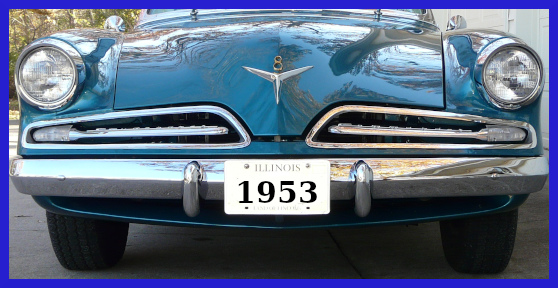 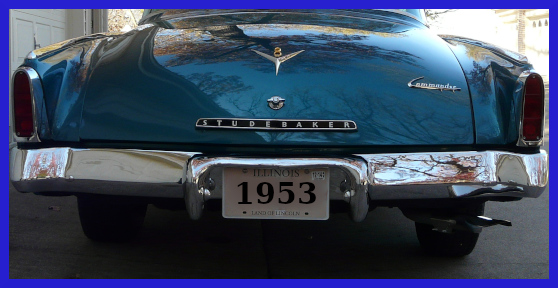 makes
it hard to tell them apart. The exterior “Tells” between them are
the front and rear badges. At the beginning of the year both lines
have the tri-star emblem, front and back, however the Commander had a
small “8” above it where Champions would have a small
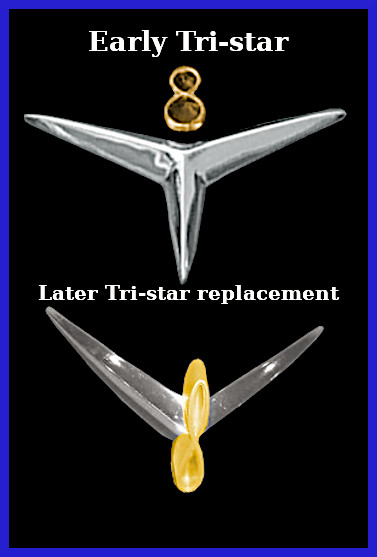 “S”.
Commander's also have a “Commander” badge on the trunk and a V8
badge on the front fender vent door. Lowey seems to have been a big
fan of the tri-star and they were seen inside, outside, and on many
of the accessory items. It seems that Mercedes-Benz didn't like the
infringement on their trademark and to keep the peace Studebaker
would replace the front and rear tri-stars with a “V” style badge
where the “8” or “S” would be larger and contained within the
“V”. The time frame for this change was sometime in January.
Coupes have a side badge just behind the door, circle "V8" for
Commanders and “S” for Champion's. 1953 Champion 2-door sedan shown, Commanders had the same flaw.
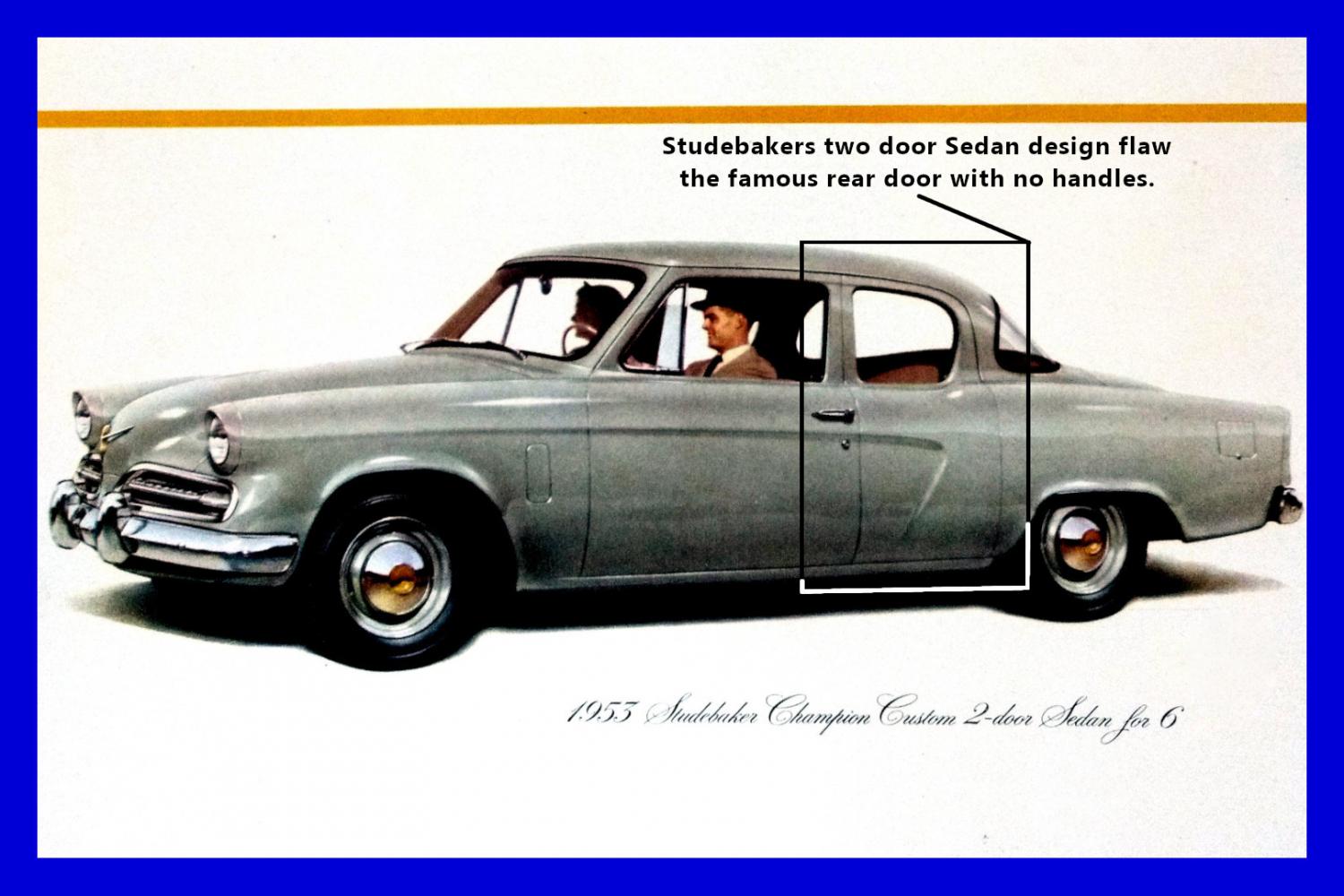 Studebaker
2 door sedans would have, until 1956, a strange ½ rear door without
handles. This design flaw is generated when for what ever reason,
Studebaker had the two and four door sedans share the same
rear-quarter panel. At least in some of the 1955 models they covered
that rear seam with trim. The reverse curve indentation side theme
would also continue for several years ending in Sedans and Wagons in
1956 and Hawks in 1957.
Mechanical
changes were few. Power Steering was first offered as an option. Studebaker started with a mechanical PS system, but it proved to be
to noisy and to expensive. Few were made, if any production units. The final version would be a Saginaw hydraulic unit. An all new
frame was designed for the lower body design. It was lightweight (13
gauge steel) and meant to flex. This did not workout very well as
excessive body noise rapidly resulted, especially in the hardtops. In later years, these frames would be prone to rust through.
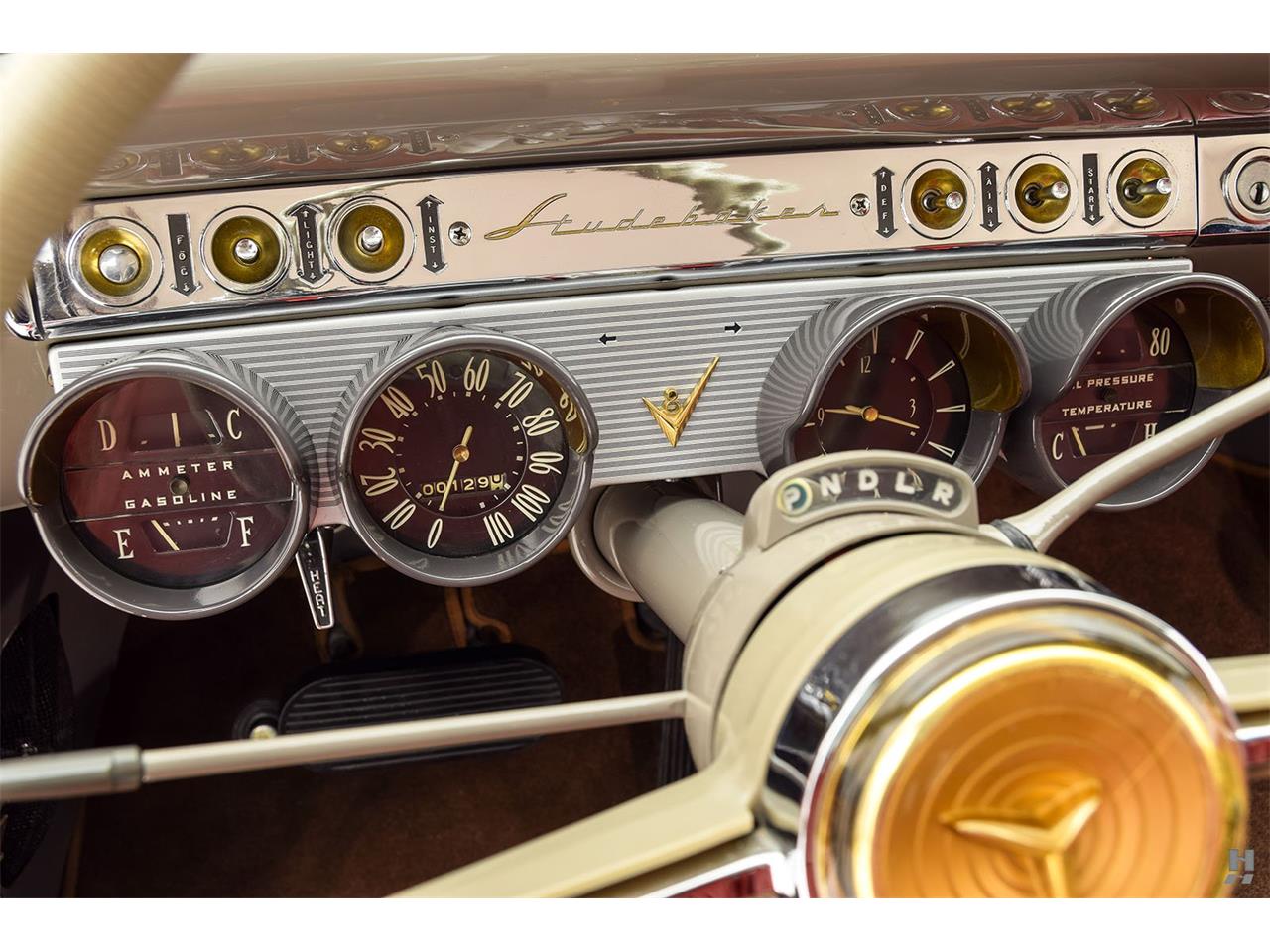 Commander's
have their own unique instrument panel with four circular hooded pods. Far
left (gas & amps), far right (Oil Pressure & Temp), center
left (Speedometer), and center right (Clock). A chrome panel above
the pods, contained up to six toggle switches, the key switch, and
radio. 1953
Commander Tells:
Commander
Deluxe (2 & 4 Door Sedan and Starlight Coupe). Chrome
headlight rings and taillight housings. Stainless trim around the
windshield and rear window, none on the side windows. Small dog dish
hubcaps. A single side trim strip over the rear fender wheel well.
Commander
Regal (2 & 4 Door Sedan, Starlight Coupe and Starliner Hardtop). Same as DeLuxe with the addition of stainless trim around the side
windows and full wheel covers. The coupes (C&K ) did not have
the trim strip above the rear-quarter wheel well, but rather had a
trim strip on top of the rear-quarter panel. The DeLuxe Starlight
did not have trim around the side windows where the Regal Starlight
did, however this trim was quite different from that found on the
Regal Sedans.
Restoration
Information:
|
Specification 1953
Studebaker Commander |
|
Engine
OHV V8 |
|
Bore (inches) |
3 3/ 8 |
|
Stroke (inches) |
3 1/4 |
|
Displacement (cu.
in.) |
232.6 |
|
Horsepower |
120@ 4,000 rpm |
|
Torque (lb-ft) |
190@ 2000 rpm |
|
Compression ratio |
7.0:1 (optional
7.5:1) |
|
Carburetor |
Stromberg model
WWUVB-26 two-barrel |
|
Electrical
Equipment |
Delco-Remy |
|
Spark Plugs |
Champion H-10 |
|
Battery |
Willard HDW-1-100 |
|
Tire Size |
7.10 x 15 |
|
Wheel Base
Commander |
116.5 inches |
|
Wheel Base
Commander Land Cruiser |
120 1/2 inches |
|
The entire engine
except the valve covers was painted olive green. The valve covers
were black. Replacement fans or oil filler caps were black.
Electrical components were black, except the overdrive relay. The
air cleaner canister was black. The carburetor, fuel pump, coil
clamp, voltage regulator base, overdrive relay, air cleaner
wingnut, battery clamp wingnuts and washers, hose clamps, and
radiator cap were natural metal color. The oil filter canister,
if factory installed was olive green. The battery box was body
color, but the top clamp was black. The radiator, radiator
support frame, and upper radiator air deflector were black. The
hood latch base in the air deflector was natural metal. Olive
Green over spray was common on the starter (if factory installed).
There were decals on the air cleaner, oil filler tube cap and oil
filter canister. The bell housing and transmission were olive
green, the rest of the drive train and chassis were painted black. |
|
Capacities |
|
Gas Tank (gals) |
18 |
|
Cooling System
(qts) |
17 1/4 ( with
climatizer add 1 1/2) |
|
Engine (qts) |
6 (w/oil filter
add one more) |
|
Rear Axle Ratio |
4.09:1 |
|
With Overdrive |
4.55:1 |
|
1953 Interior
Upholstery Materials for Commander's |
|
Models |
Standard |
Optional at Extra
Cost |
|
DeLuxe Commander (W,F,C) |
Brown and
Blue-Green Striped
Mist Blond Woolen
Broadcloth |
Scarlet Red Pleated
Leather
Golden Tan Pleated
Leather |
|
Regal Commander
(W,F,C)(except K) |
Gold-Striped Airway
Gray Nylon |
Scarlet Red Pleated
Leather
Golden Tan Pleated
Leather |
Commander Regal
Starliners 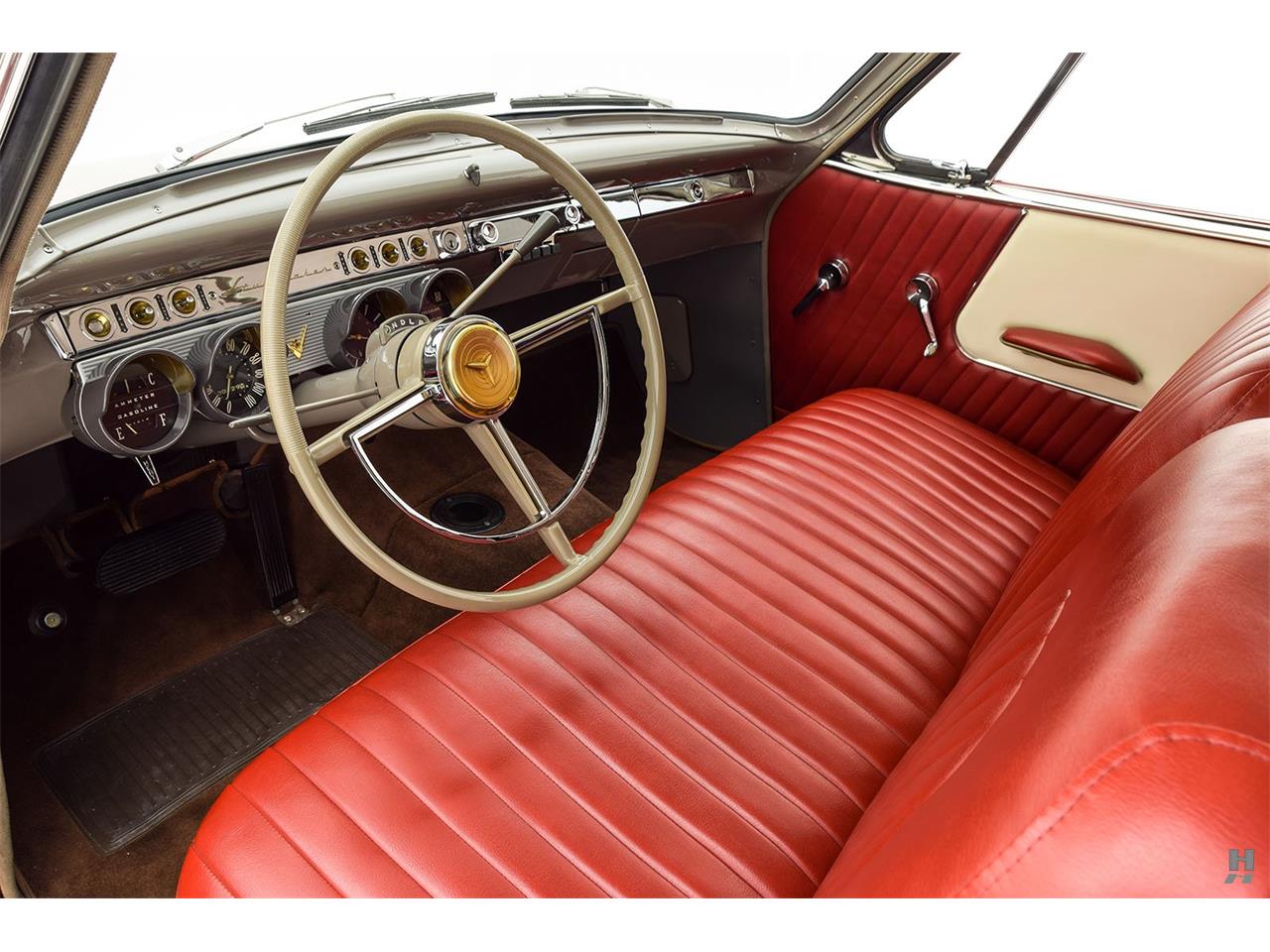 (K) |
Airway Grey Nylon
Cardinal Red Nylon1
Scarlet Red Pleated
Vinyl 2
Golden Tan Pleated
Vinyl 2
Flax Vinyl 3 |
Leather was
available on special order, but not listed listed as an option. |
|
Land Cruiser |
Two-tone Striped
Blue-Gray Broadcloth and Dark Gray Broadcloth
Two-tone Airway
Grey Nylon and Sable Taupe Nylon
Two-tone Fog Blue
Nylon and Salute Blue Nylon
|
Scarlet Red Pleated
Leather
Golden Tan Pleated
Leather |
|
1
Late in the model-year, all Starliners ordered with red nylon were
fitted with Flax vinyl cappings and the pleats in the drivers seat
backs were eliminated.
2 Vinyl
was an option, but there was no extra charge.
3
Flax (cream color) vinyl leatherette was introduced with the Salem
White/Bombay Red color combination in the spring. It was also
available in mid-year single-tone Bombay Red Starliners. There
is no information to indicate it was available with any other
colors.
Other Notes:
The vinyl and leather pleats were 1 ½ inches wide. Starliners
with Airway Grey nylon seats have Dove Gray vinyl headlining and
trim. Starliners with Red Cardinal nylon seats have Flaxed
Antiqued headlining and trim. |
Floor Covering: Deluxe
Commander's have black rubber floor covering in front and carpet in
the rear. Regal Commander and Land Cruisers have carpet front and
rear. Deluxe & Regal Commander sedans have rubber mats in the
trunk. Deluxe & Regal coupes (Starlight & Starliner) and
Land Cruiser have Mattex mats in the trunk.
Theexterior paint information was was on a label, glued to the bottom of
the glove box. Often these labels have fallen off. However, the
original paint information can be found on the production order for
your car. You can get a copy of your car's production order from
the Studebaker National Museum.
Exterior Paint Colors: 1953 Studebaker Commanders
| Color |
Supplier |
Number |
South Bend
Wheel Color |
Los Angeles
Wheel Cover |
Canadian
Wheel Cover |
| Velvet Black |
Jones-Dabney |
7696 |
Velvet Black |
Comanche Red5 |
Manchester Maroon |
| Tahoe Green1 |
Dupont |
8494 |
Tahoe Green |
Tahoe Green |
-1 |
| Chippewa Green |
Cook |
8592 |
Chippewa Green |
Tahoe Green |
Ivory Mist |
| Lombard Green2 |
Jones-Dabney |
8595 |
Lombard Green |
Lombard Green |
Lombard Green |
| Tacoma Gray |
Cook |
8607 |
Comanche Red5 |
Comanche Red5 |
Manchester Maroon |
| Olympic Gray |
Cook |
8586 |
Comanche Red5 |
Comanche Red5 |
Manchester Maroon |
| Monterey Beige1 |
Jones-Dabney |
8583 |
Monterey Beige |
Comanche Red5 |
-1 |
| Maui Blue |
Dupont |
8452 |
Nocturne Blue |
Nocturne Blue |
Nocturne Blue |
| Nocturne Blue2 |
Jones-Dabney |
8491 |
Nocturne Blue |
Nocturne Blue |
Nocturne Blue |
| Manchester Maroon2 |
Cook |
8580 |
Manchester Maroon |
Manchester Maroon |
Manchester Maroon |
| Ivory Mist |
Jones-Dabney |
8574 |
Ivory Mist |
Ivory Mist |
Ivory Mist |
| Coral Red |
Jones-Dabney |
8577 |
Coral Red |
Comanche Red5 |
Ivory Mist |
| Bombay Red3 |
Cook |
8650 |
Bombay Red |
Bombay Red |
Bombay Red |
Two-Tones (Available first only on Starliner hardtops - K Bodies.)
(Later available as an extra cost option on Starlight Coupes - C Bodies.) |
| Upper Color |
Lower Color |
Sales Dept.
Comb. No. |
Prod. Dept.
Comb. No. |
Wheel Cover |
Notes |
| Nocturne Blue |
Maui Blue |
1105 |
2465 |
Nocturne Blue |
1Not available from
the Canadian plant.
2One source indicates
this color or color
combination was not
available from the Los
Angles (Vernon) plant.
3Spring color.
4Canadian production
only.
5Was also a 1950-51
car color |
| Ivory Mist |
Maui Blue2 |
1106 |
2466 |
Nocturne Blue |
| Olympic Gray |
Tahoe Green |
1107 |
2467 |
Tahoe Green |
| Chippewa Green |
Lombard Green2 |
1108 |
2468 |
Lombard Green |
| Lombard Green |
Chippewa Green |
1109 |
2469 |
Chippewa Green |
| Coral Red |
Ivory Mist |
1110 |
2470 |
Ivory Mist |
| Nocturne Blue |
Ivory Mist2 |
1111 |
2471 |
Ivory Mist |
| Maui Blue |
Ivory Mist |
1112 |
2472 |
Ivory Mist |
| Manchester Maroon |
Olympic Gray |
1113 |
2473 |
Comanche Red5 |
| Manchester Maroon |
Olympic Gray |
1113 |
2473 |
Manchester Maroon4 |
| Monterey Beige |
Coral Red |
1114 |
2474 |
Coral Red |
| Salem White3 |
Bombay Red3 |
1115 |
2501 |
Bombay Red |
| Color Used Only On Two-tone Models |
Non-body Wheel Cover |
| Color |
Supplier |
Number |
Color |
Supplier |
Number |
| Salem White3 |
Cook |
8653 |
Comanche Red5 |
Cook |
8337 |
| Interior Metal Trim Color |
| Color |
Supplier |
Number |
| Loma Gray |
Cook |
8598 |
| Note: Bombay Red Starliners with Flax vinyl upholstery had Monterey Beige metal trim. |
1953
Studebaker Commander Series 4H, 116 1/2” / 120 1/2” wheelbase
|
1Model |
2No.
Doors |
2Passengers |
2CCD
Price |
1TW
Price |
1No.
Produced |
|
Deluxe
Starlight Coupe (C3) |
2 |
5 |
$1,921.00 |
$2,127.00 |
6,106 |
|
Deluxe
2dr sedan (F3) |
2 |
6 |
$1,894.00 |
$2,089.00 |
2,371 |
|
Deluxe
4dr sedan (W3) |
4 |
6 |
$1,927.00 |
$2,121.00 |
10,065 |
|
Regal
Starlight coupe (C5) |
2 |
5 |
$2,001.00 |
$2,213.00 |
14,752 |
|
Regal
Starliner hardtop (K5) |
2 |
5 |
$2,282.00 |
$2,374.00 |
19,236 |
|
Regal
4dr sedan (W5) |
4 |
6 |
$2,006.00 |
$2,208.00 |
7,454 |
|
Regal
Land Cruiser sedan (Y5) |
4 |
6 |
$2,151.00 |
$2,316.00 |
15,981 |
|
Total |
75,965 |
|
Source:1TW August 1994 (prices are late summer 1952) 2Classic Car
Database (CCD) TW & CCD agree exactly on the production
numbers, but like normal CCD's price is lower on average about
$200.00 |
|
Serial
Numbers |
|
Location |
Start |
End |
|
South
Bend |
8,290,001 |
8,354,900 |
|
Los
Angeles |
8,826,801 |
8,836,800 |
|
Canada |
8,955,401 |
8,956,750 |
|
Engine
Numbers |
|
Location |
Start |
End |
|
South
Bend |
V-207,001 |
VC-282,500 |
|
Canada |
VC-3,501 |
VC-4,940 |
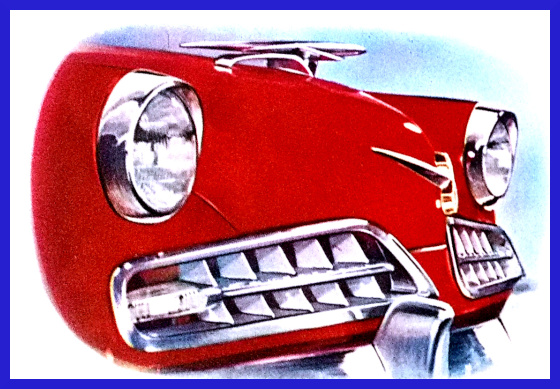 Last
years release of the all new 1953 Studebakers, left little to be done
this year, especially to the exterior. However, the new Conestoga
two door station wagon in both Deluxe and Regal trim (model D), is
the big news for this year. Designed under the direction of Robert
Bourke (Lowey and Associates). It used most of the sheet metal from
the “F” series two door sedan's, but did have it's own unique
rear-quarter panel.
Left Photo: 1954 grille and hood ornament, also note the use of the late 1953 hood badge.
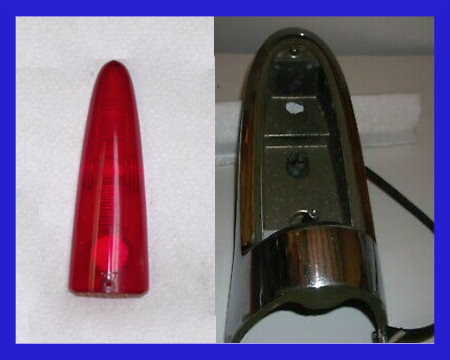 The taillights are new, with different
housings and lens. The lenses now mount with two screws and are
rounded instead of flat. The bars that segmented the 53 lens are
gone. The front bumper guards are redesigned, 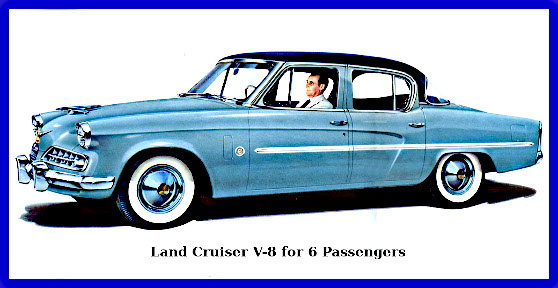 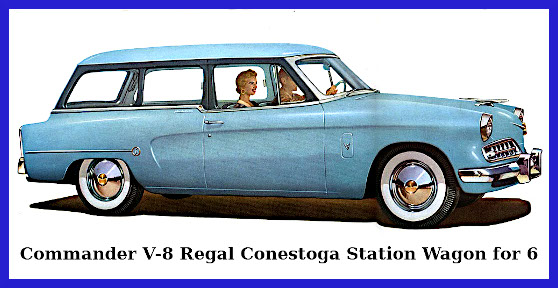 now blunt (flat) at
the front and seen on all models. The DeLuxe and Regal Sedans and
Wagon have a new Hood Ornament as standard equipment. C & K
models could add a Strat-O-styled hood ornament using AC-2610. DeLuxe sedans and wagons (looking at sales brochures) have the narrow
side trim on the rear quarter from last year. New longer and wider
side trim is fitted to Regal sedans and wagons (The Regal wagon show right above, is shown with the Deluxe sedan rear trim, however every Regal Station Wagon I found on the internet, plus later sales photos show that the longer wider Regal Sedan trim was actually used.) The trunk
handle/name plate is redesigned to include the trunk lock which was
separate on the “53's”. The “53” had “SUDEBAKER” centered
in handle, now left of the lock, is “STUDEBAKER” and right of the
lock is either “COMMANDER” or “CHAMPION”. This theme would
also be seen on the 1955 models. The three radiating lines on the
full wheel covers are eliminated shortly after 1954 production
started. The exterior sheet metal, for each body style, is the same
for Commanders and Champions, as it had been since 1951.
Interior's
are the second greatest change, (after the new wagons) and involve
new colored fabrics and interior paint, selected to harmonize with
the exterior color, not done since mid-year 1940 to1942. The steering
wheel, garnish molding, dash, door panels, headliner, and floor
covers are color matched on all trim levels.
|
1954 Interior
Upholstery Materials for Commander |
|
Models |
Standard |
Photo |
|
Deluxe Commander
Sedans & Wagon (F,W, &D) |
Sedan
seats are stairweave flat cloth, capped in pattern point
nylon-face fabric. The wagon trim is all vinyl. |
|
|
Regal Commander
Sedan (W) |
Checkered
lattice flat cloth is pleated on seats with bolsters of pattern
point nylon-face fabric. |
|
|
Regal Commander Wagon (D) |
Two-tone
wolf-grain vinyl. |
|
|
Regal Starlight
Coupe (C) |
Checkered
lattice flat cloth on the seats cushions and backs, capped with
wolf-grain vinyl. |
|
|
Commander Regal
Starliner (K) |
Seat
cushions and backs are frieze nyle-tuft nylon, with vinyl trim.
All-vinyl interiors are available at no extra cost. |
|
|
Land Cruiser (Y) |
Seat
cushions and backs are chevron nylon bolstered in nylon twill.
|
|
|
All
Commanders come with color harmonizing headlining, instrument
panel and steering wheel, coordinated to the exterior color. All
Commander interiors were available in two-tone green, blue, tan or
gray. All the Regal model door panels have pleated sections. All
Deluxe door panels were covered in flat three-tone vinyl. The
information above is captured from the 1954 Sales Brochure D-170E
11-53 |
On the C
& K cars the rear center arm rest is a removable version, unique
to 1954 only. The hand brake 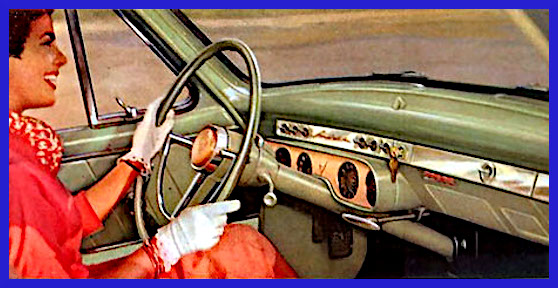 handle changes from pistol grip to
horizontal T-bar. The four hooded pod style gauges are gone in favor
of a oblong circular surround, which now holds the same four gauge
pattern seen in 1953. This would be the last year the Commander and
Champion would have different instrument panels.
Mechanical
changes were few. The frame is modified with an extended engine rear
cross member on sedans and wagons. An additional frame cross member
is added to the C&K bodies. Both much needed improvements. The
rear brake drum size is increased to 10 inches and self adjusters are
eliminated in favor of manual adjustment. Engine compression ratio
is increased by ½ point (See Spec's Chart Below). New clutch petal
shaft part are used and tubeless tires are introduced during this
model-year.
In June
of 1954 Studebaker introduced the Ambulet in both the
Commander and Champion lines, a Conestoga wagon fitted with special
emergency equipment that included sirens, red flashers, and cots.
Also offered in the commercial line would be a Sedan Delivery,
essentially a wagon with the rear windows blanked out and the rear
seat eliminated.
On
October 1st, 1954 Studebaker and Packard would become the
Studebaker-Packard Corporation. Neither company would significantly
improve it's status from the agreement, especially Packard.
Restoration
Information:
|
Specification 1954
Studebaker Commander |
|
Engine
OHV V8 |
|
Bore (inches) |
3 3/ 8 |
|
Stroke (inches) |
3 1/4 |
|
Displacement (cu.
in.) |
232.6 |
|
Horsepower |
127@ 4,000 rpm |
|
Torque (lb-ft) |
202@ 2000 rpm |
|
Compression ratio |
7.5:1 |
|
Carburetor |
Stromberg model
WWUVL-26 two-barrel |
|
Electrical
Equipment |
Delco-Remy |
|
Spark Plugs |
Champion H-10 |
|
Battery |
Willard HDW-1-100 |
|
Tire Size |
7.10 x 15 |
|
Wheel Base
Commander |
116.5 inches |
|
Wheel Base
Commander Land Cruiser |
120 1/2 inches |
|
The entire engine
except the valve covers was painted olive green. The valve covers
were black. Replacement fans or oil filler caps were black.
Electrical components were black, except the overdrive relay. The
air cleaner canister was black. The carburetor, fuel pump, coil
clamp, voltage regulator base, overdrive relay, air cleaner
wingnut, battery clamp wingnuts and washers, hose clamps, and
radiator cap were natural metal color. The oil filter canister,
if factory installed was olive green. The battery box was body
color, but the top clamp was black. The radiator, radiator
support frame, and upper radiator air deflector were black. The
hood latch base in the air deflector was natural metal. Olive
Green over spray was common on the starter (if factory installed).
There were decals on the air cleaner, oil filler tube cap and oil
filter canister. The bell housing and transmission were olive
green, the rest of the drive train and chassis were painted black. |
|
Capacities |
|
Gas Tank (gals) |
18 |
|
Cooling System
(qts) |
17 1/4 ( with
climatizer add 1 1/2) |
|
Engine (qts) |
6 (w/oil filter
add one more) |
|
Rear Axle Ratio |
4.09:1 |
|
With Overdrive |
4.55:1 |
|
1954 Exterior
Paint Colors |
Passenger Car
Two-tones (Upper/Lower)
(Not
Available on Champion Custom Model) |
|
Passenger Car Solid Paint Colors |
Combo No. |
Colors |
|
Safford Cream |
Sandusky Beige |
1158 |
Azore Green/Lance Green1 |
|
Azore Green |
Elko Grey3 |
1159 |
Lance Green/Azore Green |
|
Vista Green |
Cadet Grey |
1161 |
Ontario Blue/Safford Cream |
|
Lance Green1 |
Chadron Red |
1162 |
Nocturne Blue/Vienna Blue |
|
Vienna Blue |
Shoshone Red |
1163 |
Sandusky Beige/Chadron Red |
|
Alberta Blue1 |
Velvet Black |
1164 |
Sandusky Beige/Shoshone Red |
|
Nocturne Blue2 |
|
1165 |
Ontario Blue/Elko Gray3 |
|
Station Wagon
Solid Colors |
1166 |
Shoshone Red/Sandusky Beige |
|
Azore Green |
Elko Grey5 |
1167 |
Velvet Black/Safford Cream |
|
Lance Green1 |
Shoshone Red |
1168 |
Velvet Black/Chadron Red |
|
Alberta Blue1 |
Mesa Tan |
? |
Cadet Grey/Nocturne Blue2 |
|
Vienna Blue |
Safford Cream5 |
? |
Nocturne Blue/Cadet Gray4 |
|
Cadet Grey |
Velvet Black |
? |
Ontario Blue/Cadet Gray2 |
|
Shasta White6 |
|
|
|
Station Wagon
Two-tones (Upper/Lower) (Not
Available on DeLuxe Conestogas) |
|
Combo No. |
Colors |
|
1200 |
Mesa Tan/Safford Green5 |
|
1201 |
Ontario Blue/Elko Gray5 |
|
1204 |
Nocturne Blue/Vienna Blue |
|
1205 |
Lance Green/Azore Green |
|
1206 |
Azore Green/Lance Green1 |
|
1207 |
Sandusky Beige/Shoshone Red |
|
1208 |
Elko Grey/Alberta Blue1 |
|
South Bend Only1
Canada Only2 Not Available
Canada3 Mid-year color combo NA
from LA Plant4
Los Angeles Only5
Extra Cost color for Ambulet Only6 |
1954
Studebaker Commander Series 5H, 116.51
/ 120.52 in. wheelbase
|
Model |
No. Doors |
Passengers |
CCD Price |
TW Price |
No. Produced |
|
DeLuxe Starlight Coupe
(C3)2 |
2 |
5 |
$2,030.00 |
$2,233.00 |
2,868 |
|
Regal Starlight Coupe (C5)2 |
2 |
5 |
$2,130.00 |
$2,341.00 |
3,151 |
|
DeLuxe Sedan (F3)1 |
2 |
6 |
$1,940.00 |
$2,136.00 |
1,086 |
|
DeLuxe Sedan (W3)1 |
4 |
6 |
$1,980.00 |
$2,179.00 |
4,615 |
|
Regal Sedan (W5)1 |
4 |
6 |
$2,080.00 |
$2,287.00 |
2,571 |
|
Regal Starliner HT (K5)2 |
2 |
6 |
$2,220.00 |
$2,502.00 |
5,040 |
|
DeLuxe Conestoga Wagon
(D3)1 |
2 |
6 |
$2,230.00 |
$2,448.00 |
1,912 |
|
Regal Conestoga Wagon (D5)1 |
2 |
6 |
$2,280.00 |
$2,556.00 |
2,878 |
|
Regal Land Cruiser Sedan
(Y5) |
4 |
6 |
$2,230.00 |
$2,438.00 |
6,383 |
|
Total |
30,504 |
|
Serial
Numbers |
|
Location |
Start |
End |
|
South
Bend |
8,354,901 |
8,380,6011 |
|
Los
Angeles |
8,836,801 |
8,841,2011 |
|
Canada |
8,956,751 |
8,957,6011 |
|
1These
number are taken from the starting 1955 serial numbers. |
|
Engine
Numbers |
|
Location |
Start |
End |
|
South
Bend |
V-282,501 |
V-312,7001 |
|
Canada |
VC-4,941 |
VC-5,7001 |
|
1These
number are derived from the starting 1955 224 cu. in. V-8 engine
numbers. We don't know for sure the last 232 V-8 engine number.
However, the span seems consistent with production. |
This
is the year that Studebaker decided to get into the chrome and color
game with the big three, GM, Ford, and Chrysler. Harley Earl of GM
fame, once stated “if a little chrome is good, then a lot of chrome
is better.” Some would say that this departure from the Lowey,
“remove all the trim”, 1953 design, was radical and on-necessary. Others think it is the most typical 50's look Studebaker ever
produced. No question it was a mix of both, the slopping 53 design,
and lots of chrome. Love it or leave it.
Several
things happened this year which made 1955 cars survivors. First the
built quality was much better then 53 & 54, especially the early
1953's. The chrome is better then either of the prior two years and
this is the first year vinyl covered wiring is introduced. A lot
more options are available which made the cars more user friendly,
like power steering, power brakes, power windows, and power seats. Even air conditioning is offered on Commanders.
The
Commander and Champion Models for 1955 were identical, as were their
sheet-metal and trim. Even the dash is nearly identical across the
entire Studebaker line-up. The thing that clearly identifies
Commanders from the exterior, is that they have a rear-quarter panel
name badge, as did the Presidents. The upper badge on the trunk has
an “8” where Champion has a “S” and the right side of the
deck lid lift handle said “Commander.” The basic difference
between Commanders and Champions is the engine. Commanders have V8's
and Champion's have flat-head sixes.
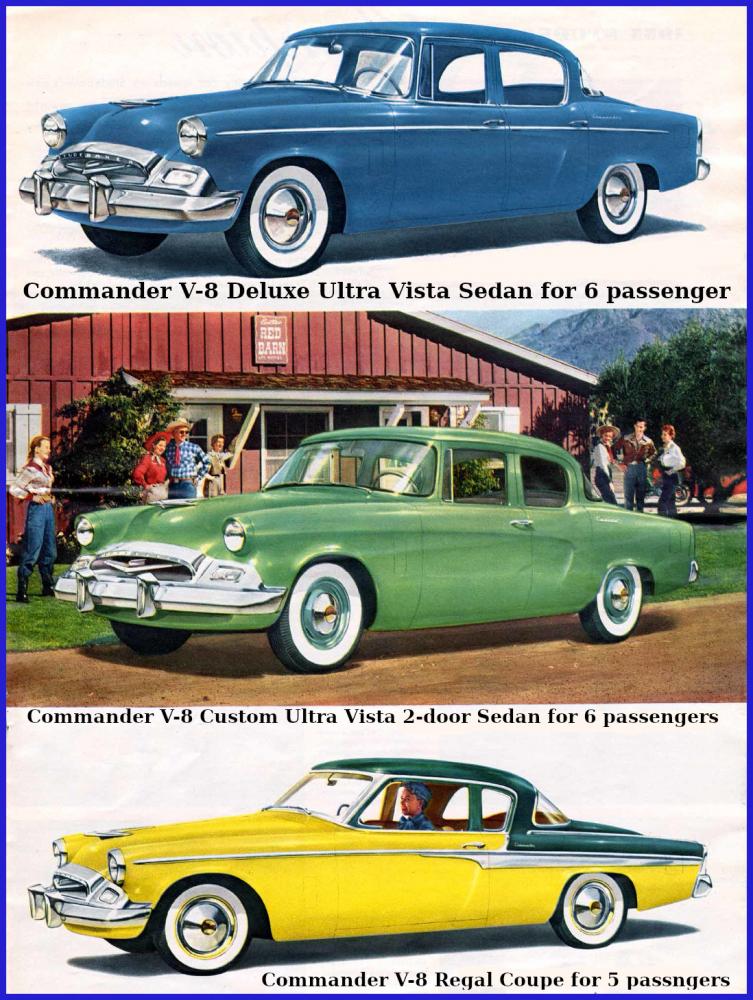 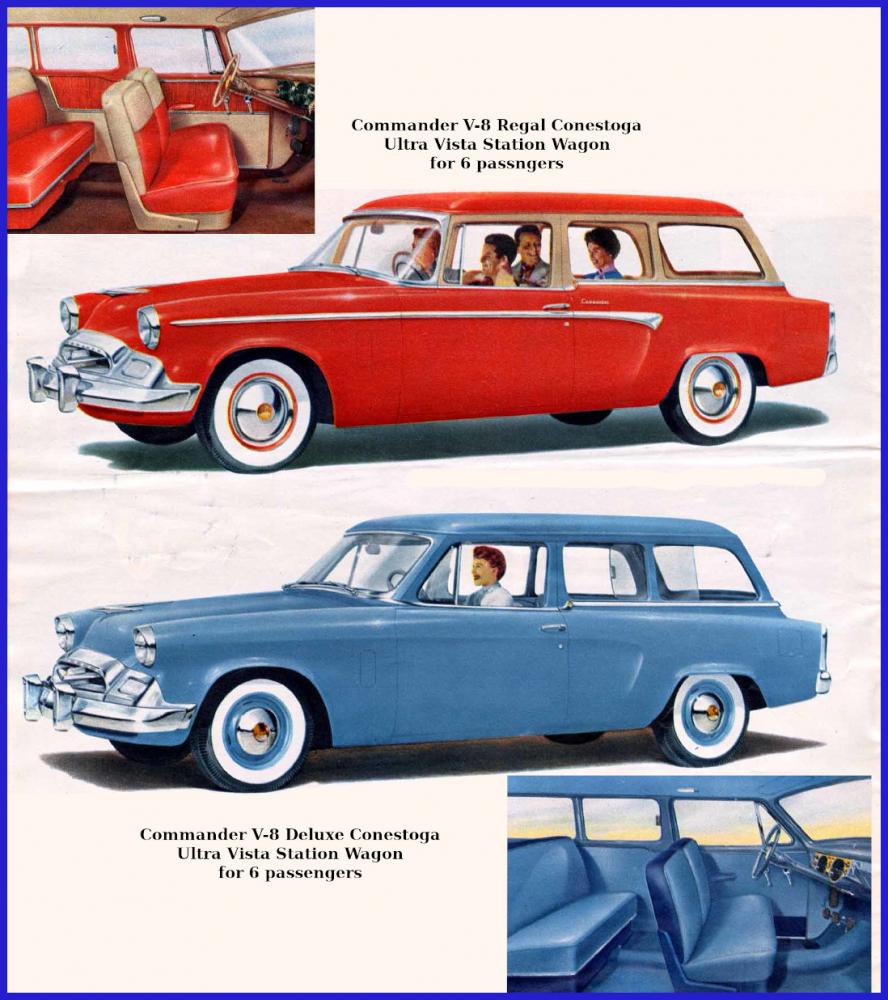 Commanders now come in three trim levels. In Custom trim, a 2dr Sedan, a 4dr Sedan (left center photo). In Deluxe trim, a 2dr Sedan, a 4dr Sedan, a
Coupe, and a 2dr Conestoga Station Wagon (left top & right bottom photo.) In Regal trim, a 4dr
Sedan, a Coupe, a Hard-top, and a 2dr Conestoga Station Wagon (left bottom and right top photo.) The Custom series have painted headlight rings and painted tail light housings, no side trim and no moldings around the windows. The Custom 2-door sedan would still feature that weird looking full height break line at the "C" pillar, creating that illusion of a rear door without handles. Deluxe and Regal Commanders have chrome headlight rims and taillight housings and window & belt-line chrome trim. The
Deluxe 4dr Sedan has a full length narrow side molding just below the
door handles. The Deluxe 2dr Sedan has a wide vertical trim piece
that covers that seam at the rear “C” pillar and then has a
horizontal narrow trim extending thru the center of the vertical
trim, longer in the rear then in the front. The Deluxe Coupe has
window and belt-line treatment like the sedans. It has no side trim,
but has trim on top of the rear quarter-panels. The Deluxe wagon has
no stainless around the side windows and no lower side trim, but does
have front and rear window stainless and a belt-line molding. Regal
Sedan's have all the trim of the Deluxe Sedans, plus the “Butter
Knife” (sweep spear) trim which extended just below the Deluxe side
trim. The Regal Coupe and Hardtop have full length side trim with
the “Butter Knife” treatment. The Regal Wagon has it's own
unique side trim, which is wider and ends with a flair right at the
reverse indented curve behind the door. Regal Wagons and Regal 4dr Sedans have a stainless mini-sun
visor above the 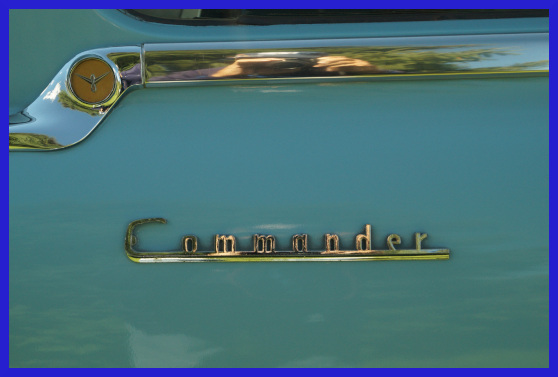 windshield. Both Commander Wagons have a round “V8”
plastic medallion built in the belt-line molding at the “B”
pillar, have a "Commander" badge on the side and have “Conestoga” badge on the tailgate. The photo at the left is of a Deluxe model.
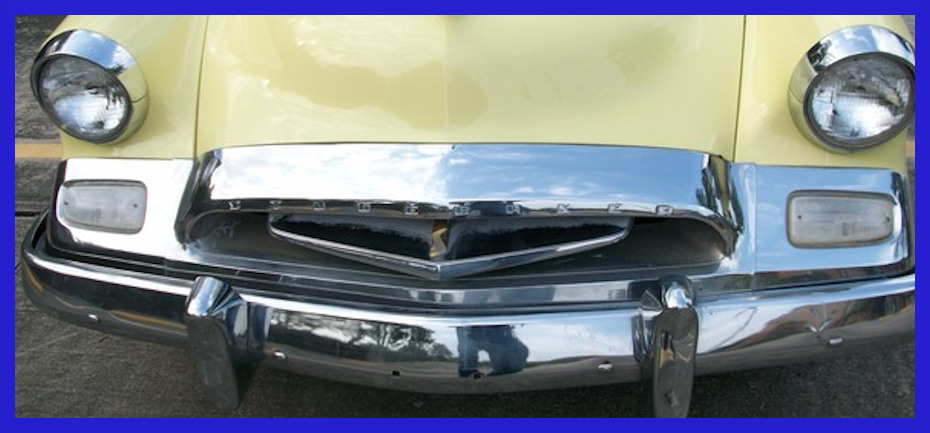 The
bodies for 1955 are a continuation of the 1953 design (1954 for
wagons). The big news was a new grille with a floating center
insert. The center section was the same across all models, but the
side sections which held the parking light were not interchangeable
between the Coupe/Hardtop & Sedan/Wagon. Except for the
Conestoga Wagon rear bumper, the bumpers are made larger, thus the
1953 & 1954 bumper guards and fog lights will not fit 1955 cars. These bumpers are now single piece design. This bumper design would
be used (with some bolt hole changes) on the front of 1956 Sedans &
Wagons and later yet on 1964 C&K models. The Conestoga rear
bumper was the same as 53 & 54 Sedans and 54 Wagons. The 55
Wagon taillight housing and lens were 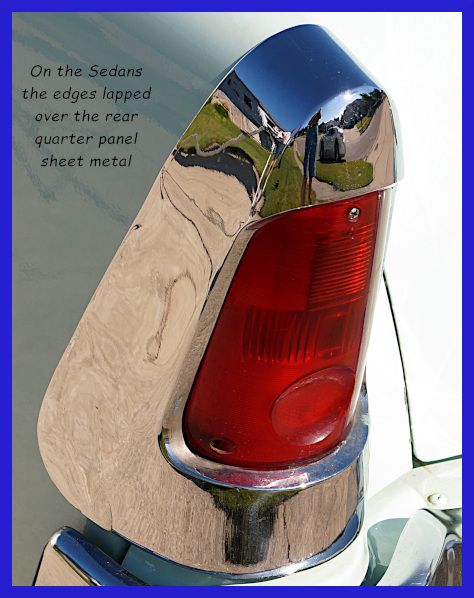 the same as 1954, but the
Sedans and C&K cars had redesigned units. The Sedans and C&K
housing and lens were not interchangeable as the Sedan design was
much larger. The Sedan taillight housing actually wrapped around the
edge of the rear fender. Robert Bourke was in charge of all the 1955
styling.
As
mentioned earlier, two-tone paint in bright colors was certainly in
for 1955 and could be had on Deluxe or Regal Sedan models for $18.28
or on Coupes or Hardtops for $22.58. Interior fabrics and colors
were also spectacular, designed by Eleanor LeMaire and changed
several times during the model-year. A new instrument cluster is
used, featuring two large round dials mounted in a grooved panel
(gold on early models) with four toggle switches mounted, two on each
side. Signal light indicators and a “V8” are placed in between
the dials. Regal models had full circle horn ring with a gold horn
button. Commander Regal Hardtops had front and rear carpeting, Regal
Sedans & Coupes had rear floor carpeting with black rubber on the
front floor. All other models featured all black rubber flooring. For the third year in a row, the Coupe and Hardtop rear center arm
rest is redesigned. In 1953 it was fixed, in 1954 it was removable,
and this year it is made to hinge down between the seats.
|
1955 Interior
Upholstery Materials for Commander |
|
The following
information is provided as a sample of the many interior standards
and options available at different times during the 1955
model-year. These are taken from the January 1955 Sales Brochure and
are likely different then what was seen at the start of production
in the fall of 1954 or after the final changes were released in
April of 1955. |
|
Models |
Standard |
Photo |
|
Deluxe Commander
Sedan (F4 & W4) |
Ripple-weave
cord cloth with Point pattern nylon caps and appointments. Only
the 4-door sedan was shown in the Sales Brochure, but most likely
was the same for F4 |
|
|
Regal Commander
Sedan (F6 &W6) |
Corded
cloth with pattern point nylon caps and appointments. Only
the 4-door sedan was shown in the Sales Brochure, but most likely
was the same for F4 |
|
|
Regal Starlight
Coupe (C) |
Checkered
lattice flat cloth with pattern pointed nylon caps and
appointments. |
|
|
Deluxe Commander
Wagon (D4) |
Two-tone
Vinyl. |
|
|
Regal Commander
Wagon (D6) |
Two-tone
Vinyl. |
|
|
The
information above is captured from the 1955 Sales Brochure D-221
1-55. After initial production began in the fall of 1954 there
were at least two major interior revision for the 1955 model year,
they were January of 1955 and April of 1955. |
Mid-year
(January) Studebaker would release in the Sedan and Wagons models
it's Ultra Vista models (wrap-around windshield). The C&K models
would not get this treatment. This was a significant modification
requiring a new windshield, new windshield trim, new front doors, new
windwings & glass, new instrument panel, and a modified cowl.
The same “instruments would be used in the new dash, but the bezels
would be changed. The toggle switches would be replaced with
push-pull switches and the “V8” between the dials would be
eliminated . Early Commander Sedan and Wagon models have odd numbers
(F1,F3, W1, W3, D3, & D5). The later Ultra Vista Models would
have even numbers (F2, F4, W2, W4, D4, & D6). Several new
accessories would be required which included radios and Climatizer.
Three new options are also introduced in January, power windows,
power seat, and air conditioning. Air was only available on V8's
(Commanders & Presidents).
Restoration
Information:
|
Specification 1955
Studebaker Commander |
|
224
Pace-setter (earlier) OHV V8 |
|
Bore (inches) |
3 9/16 |
|
Stroke (inches) |
2 13/16 |
|
Displacement (cu.
in.) |
224.3 |
|
Horsepower |
104@ 4,500 rpm
/ 1124@4,500
rpm |
|
Torque (lb-ft) |
202@ 2,800 rpm /1209@3,200
rpm |
|
Compression ratio |
7.5:1 optional
8.0:1 |
|
259
Bearcat (late) OHV V8 |
|
Bore (inches) |
3 9/16 |
|
Stroke (inches) |
3 1/4 |
|
Displacement (cu.
in.) |
259.2 |
|
Horsepower |
162@ 4,500 rpm /2182@4,500 rpm |
|
Torque (lb-ft) |
250 @ 2,800 / 2? |
|
Compression ratio |
7.5:1 optional
8.0:1 |
|
Carburetor |
Stromberg model WW
two-barrel |
|
Carburetor (opt.
4bbl) |
Carter WCFB
four-barrel |
|
Electrical
Equipment |
Delco-Remy |
|
Spark Plugs |
Champion H-11 |
|
Battery |
Willard HWD-1-100 |
|
Tire Size |
6.70 x 15 |
|
Wheel Base
Commander F,W&D |
116.5 inches |
|
Wheel Base
Commander C&K |
120 1/2 inches |
|
1The
four-barrel option was not introduced until after the 224 V8 was
discontinued, however it was pushed as a dealer installed option. 1&2The additional HP listed above could only
be achieved if the duel exhaust accessory was also installed. The
entire engine except the valve covers was painted Alberta Blue (a
1954 exterior paint color). Some time late in the year, the
engine color changed to Turquoise, the same color would be used on
1956 and 1957 engines. The valve covers, oil filler cap, and air
cleaner were painted silver. Electrical components were black,
except the overdrive relay. The carburetor, fuel pump, coil
clamp, voltage regulator base, overdrive relay, air cleaner
wingnut, battery clamp wingnuts and washers, hose clamps, and
radiator cap were natural metal color. The oil filter canister,
if factory installed was engine color, add-on Fram oil filters
were Fram orange with black lids. The fan would be engine color,
but some fans were black. The battery box was body color, but the
top clamp was black. The radiator, radiator support frame, and
upper radiator air deflector were black. The hood latch base in
the air deflector was natural metal. Engine color over spray was
common on the starter and fuel pump (if factory installed). There
were decals on the air cleaner, oil filler tube cap and oil filter
canister. The valve covers have engine decals, either
“Pass-master” or “Bearcat”. The bell housing and
transmission were engine color, the rest of the drive train and
chassis was painted black. |
|
Capacities |
|
Gas Tank (gals) |
18 |
|
Cooling System
(qts) |
17 1/4 ( with
climatizer add 1 1/2) |
|
Engine (qts) |
6 (w/oil filter
add one more) |
|
Rear Axle Ratio |
4.09:1 |
|
With Overdrive |
4.55:1 |
|
Exterior Colors:
1955 Cars & Wagons |
|
Solid Colors |
|
Color |
Sedan & Coupe/HT Code |
Station Wagon Code |
|
Velvet Black |
2580 |
2597 |
|
Encino Cream1 |
2581 |
2598 |
|
Saginaw Green |
2582 |
2599 |
|
Pima Red1&2 |
2583 |
2601 |
|
Cascade Green1 |
2584 |
2602 |
|
Tilden Grey |
2585 |
2603 |
|
Alpine Blue |
2586 |
2604 |
|
Windsor Blue1 |
2587 |
2605 |
|
Shasta White3 |
---- |
2614 |
|
Rancho Red1&4 |
2653 |
2654 |
|
Shoshone Red5 |
? |
---- |
|
1Not available on Custom
models.
2Early Color.
3Available only on Ambulet.
4Spring Color.
5Canadian color in 1955.
Solid colors are not listed for Speedster,
but they could be special ordered.
Wheels were painted body color. |
|
Two-Tones
(except Custom models and the Speedster) |
|
Upper Color |
Lower Color |
Note(s) |
Early Seden &
Coupe/HT Code* |
Late Seden &
Coupe/HT Code* |
Station Wagon
Code |
|
Windsor Blue |
Alpena Blue |
|
2588 |
2641 |
2606 |
|
Sonora Beige |
Saginaw Green |
1 |
2589 |
2642 |
2607 |
|
Sonora Beige |
Encino Cream |
1 |
2590 |
2643 |
2608 |
|
Sheridan Green |
Cascade Green |
|
2591 |
2644 |
2609 |
|
Velvet Black |
Pima Red |
1 |
2592 |
2645 |
2610 |
|
Sheridan Green |
Encino Cream |
|
2593 |
2646 |
2611 |
|
Sonora Beige |
Pima Red |
1 |
2594 |
2647 |
2612 |
|
Pima Red |
Tilden Grey |
1 |
2595 |
2648 |
2613 |
|
Velvet Black |
Rancho Red |
2 |
--- |
2650 |
2655 |
|
Rancho Red |
Tilden Grey |
2 |
--- |
2652 |
2657 |
|
Shasta White |
Saginaw Green |
2 |
--- |
2658 |
2661 |
|
Shasta White |
Rancho Red |
2 |
--- |
2659 |
2662 |
|
Shasta White |
Encino Cream |
2 |
--- |
2660 |
2663 |
|
Shasta White |
Velvet Black |
2&3 |
--- |
2665 |
2664 |
|
Velvet Black |
Coraltone |
2&4 |
--- |
2666 |
--- |
|
Coraltone |
Shasta White |
5 |
--- |
2667 |
--- |
|
Shasta White |
Windsor Blue |
2&3 |
--- |
2668 |
2669 |
|
Sonora Beige |
Shoshone Red |
6 |
? |
? |
--- |
|
Shasta White |
Shoshone Red |
2&6 |
--- |
? |
--- |
|
1Early combinations.
2Spring
combinations.
3Not available on President Deluxe Sedan.
4Not
available on President Deluxe Sedan & Station Wagon.
5Very
late combinations.
6Canadian combinations.
Early Sedan and
Coupe/Hardtop codes may have been used on some very early station
wagons. Two-tones were not available on Custom models. Wheels
were painted the “lower” color. |
*
In January 1955, the two-tone break line on Regal models was lowered
to include the deck lid, upper rear quarter panels, and sometimes the
B pillar in the "upper" color.
This
change came at the following serial numbers for the Commander line:
South
Bend @ 8,397,201 - Los Angeles @ 8,843,001 - Canada @ 8,958,101
|
11955
Studebaker Commander 16G8 |
|
Model |
No. Doors |
Passengers |
CCD Price |
TW Price |
No. Produced |
|
Custom
2dr Sedan (F1 & F2) |
2 |
6 |
$1528.00 |
$1,873.00 |
1,413 |
|
Deluxe
2dr Sedan (F3 & F4) |
2 |
6 |
$1,617.00 |
$1,969.00 |
6,834 |
|
Custom
4dr Sedan (W1 & W2) |
4 |
6 |
$1570.00 |
$1,919.00 |
2,082 |
|
Deluxe
4dr Sedan (W3 & W4) |
2 |
6 |
$1,664.00 |
$2,014.00 |
16,768 |
|
Regal
4dr Sedan (W5 & W6) |
4 |
6 |
$2,058.00 |
$2,127.00 |
9,985 |
|
Deluxe
Coupe (C3) |
2 |
5 |
$1,678.00 |
$1,989.00 |
6,975 |
|
Regal
Coupe (C5) |
2 |
5 |
|
$2,094.00 |
4,639 |
|
Regal
2dr Hardtop (K5) |
2 |
5 |
$1,901.00 |
$2,282.00 |
3,296 |
|
Deluxe
Station Wagon (D3 & D4) |
2 |
6 |
$1,961.00 |
$2,274.00 |
4,280 |
|
Regal
Wagon (D5 & D6) |
2 |
6 |
$2,058.00 |
$2,445.00 |
2,516 |
|
Total |
58,788 |
|
“TW
Price” was advertised delivery price. Odd body codes 1,3,5 are
early models with conventional windshields. Even body codes
2,4,6 are wrap-around windshields (Ultra Vista). C&K models
were only produced with conventional windshields. |
|
1Serial
Numbers (224 V8) |
|
Location |
Start |
End |
|
South
Bend |
8,380,601 |
8,397,200 |
|
Los
Angeles |
8,841,201 |
8,843,000 |
|
Canada |
8,957,601 |
8,958,100 |
|
1Serial
Numbers (259 V8) |
|
Location |
Start |
End |
|
South
Bend |
8,397,201 |
8,429,407 |
|
Los
Angeles |
8,843,001 |
8,849,083 |
|
Canada |
8,958,101 |
8,960,000 |
|
1(224) Engine Numbers |
|
Location |
Start |
End |
|
South Bend |
V-312,701 |
V-331,100 |
|
Canada |
VC-5,701 |
VC-6,200 |
|
These number rounded up to the nearest 100 |
|
1(259) Engine Numbers |
|
Location |
Start |
End |
|
South Bend |
V-331,101 |
V-363,750 |
|
Los Angeles |
VL-101 |
VL-6,300 |
|
Canada |
VC-6,201 |
VC-8,100 |
These number rounded up to the nearest 50 or 100 |
1Source TW February 1994 (Fred Fox Featured Article)
|
|
|
|
|
|
|
|
 |
|